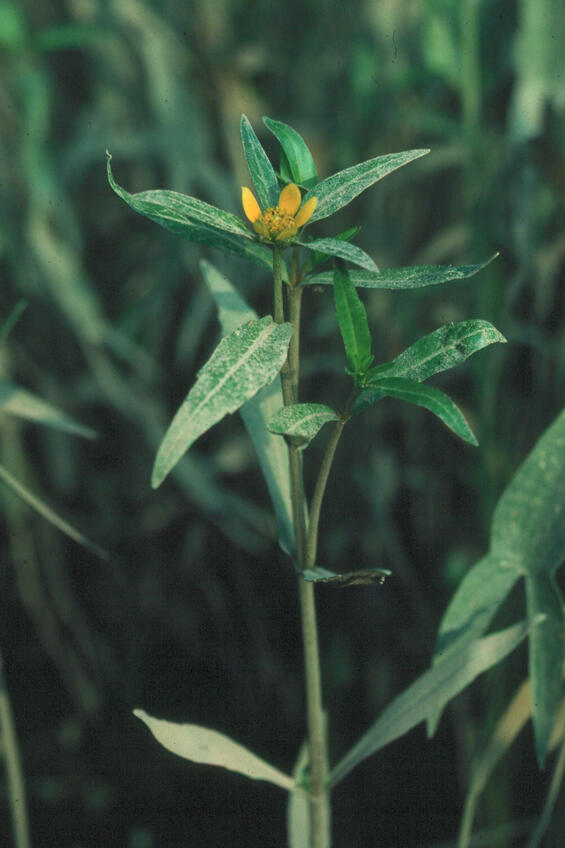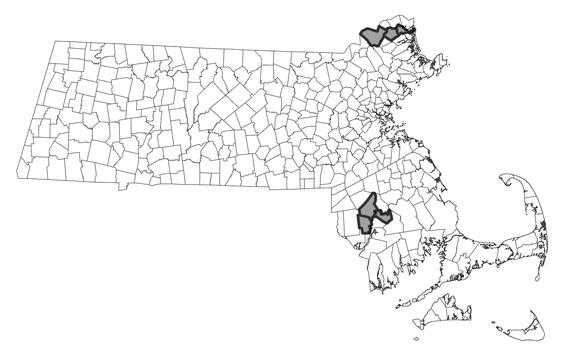- Scientific name: Bidens eatonii Fernald
- Species of Greatest Conservation Need (MA State Wildlife Action Plan)
- Endangered (MA Endangered Species Act)
Description

Eaton's beggar-ticks. Photo credit: Bruce A. Sorrie
Eaton's beggar-ticks is a globally rare, slender, annual herb of tidal river shores that grows to a height of 70 cm (27.5 in). Its lance-shaped leaves are toothed, 4-12 cm (1.6-4.7 in) long, and borne opposite one another on the stem. Occasionally, the lower leaves will possess one or two lateral lobes. Its flowers are very small and are aggregated into groups that falsely resemble a larger flower, called capitula. The small, seed-like fruits, called cypselas, bear slender, barbed bristles that are capable of attaching to fur and clothing. These fruits, which beg a ride with unsuspecting passers-by, are responsible for the common name of the genus Bidens.
Eaton's beggar-ticks is distinguished from closely related species by examining its leaves, capitula, and cypselas. The leaves are simple or lobed (but not divided) and are borne on stalks (petioles) 1-4 cm (0.39-1.6 in) long. The capitula of Eaton's beggar-ticks are largely comprised of disk flowers. These flowers are tubular shaped. Ray flowers, like the white, flat, marginal flowers of the ox-eye daisy (Leucanthemum vulgare), are either absent or very short (under 5 mm [0.2 in] long). Each capitulum of Eaton's beggar-ticks is made up of 7–30 flowers. The cypselas of this species are wedge-shaped, flat at the apex, bear two to four barbed bristles, and are longitudinally striate (and not warty).
In Massachusetts, there are other species of beggar-ticks with simple or lobed (but not divided) leaves that occur in similar habitats as Eaton's beggar-ticks. Estuary beggar-ticks (Bidens hyperborea), another Endangered species, and smooth beggar-ticks (Bidens laevis) are species that occur in tidal river shore communities. Both of these species have leaves that lack petioles, at least near the middle and upper parts of the stem. Also, smooth beggar-ticks has capitula with comparatively large, yellow ray flowers, unlike the tiny ray flowers sometimes found on the capitula of Eaton's beggar-ticks. It is more difficult to tell purple-stemmed beggar-ticks (Bidens connata) from Eaton's beggar-ticks. This common and wide-ranging species is frequent in non-tidal habitats but also occurs along fresh tidal river shores. It usually has more flowers per capitulum (20-65, rarely up to 150) and has cypselas that are diamond-shaped in cross-section and are warty-tuberculate on the faces (when viewed with 10× or greater magnification).

Population status
Eaton's beggar-ticks is currently listed under the Massachusetts Endangered Species Act as Endangered. All listed species are protected from killing, collecting, possessing, or sale and from activities that would destroy habitat and thus directly or indirectly cause mortality or disrupt critical behaviors. In addition to being rare in Massachusetts and throughout the New England Region, Eaton’s beggar-ticks is considered to be imperiled at a global scale. It is limited by its restricted range and its uncommon fresh-brackish estuarine habitat. MassWildlife’s Natural Heritage & Endangered Species Program database has 7 records from 2 counties: Essex and Bristol. Three observations have been verified since 1999, the other 4 have not been recently relocated.
Distribution and abundance
Eaton's beggar-tick is considered globally rare and has a limited range. It is considered rare in every state and province where it occurs. It is critically imperiled in Connecticut, Massachusetts, New Brunswick, New Jersey and New York, imperiled in Maine and vulnerable in Quebec.

Distribution in Massachusetts
1999-2024
Based on records in the Natural Heritage Database
Habitat
Eaton's beggar-ticks occurs on fresh to brackish tidal river shores. It is normally found growing on wet, muddy substrates. The communities range from a narrow band of tidal muck along the river shore to an extensive estuarine marsh. Associated species in Massachusetts include Parker's pipewort (Eriocaulon parkeri), common water-purslane (Ludwigia palustris), wild rice (Zizania aquatica), water parsnip (Sium suave), common three-square (Schoenoplectus pungens), and saltmarsh-hemp (Amaranthus cannabinus). At one site in southern Massachusetts, purple-stemmed beggar-ticks occurs with Eaton's beggar-ticks and hybrids between the two species can be found.
Healthy habitats are vital for supporting native wildlife and plants. Explore habitats and learn about conservation and restoration in Massachusetts.
Contact
| Date published: | April 7, 2025 |
|---|